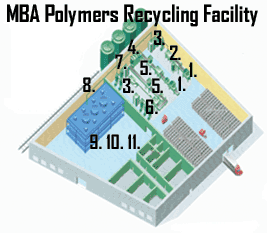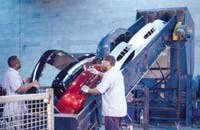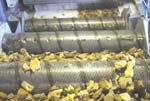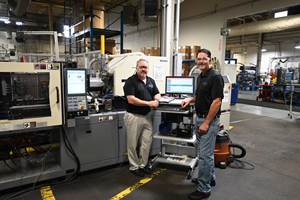Commingled Plastic Waste: New Gold Mine for Automotive Processors
Instead of going to landfills, previously unusable mixed waste like auto shredder residue is yielding a new trove of inexpensive engineering resins for car parts. Sortation technologies derived from the mining industry can pull out usable ABS, PC, acrylic, PP, TPO, and PPO alloys.
Reprocessors and automotive OEMs are paying new attention to heavily mixed plastic scrap, especially if it contains costly engineering resins like ABS, polycarbonate, acrylic or nylon. Clean engineering-resin scrap always had value; but thanks to a weaker economy, reprocessors are now going after some abundant, but far harder-to-exploit sources like auto shredder residue (ASR) and scrap contaminated with paint, coatings, metals, and other plastics. “Automotive molders have been pushed hard for cost reductions, and this is one of the few cost savings left,” notes Mark Lieberman, president of American Commodities, a reclaimer of high-value plastics from painted bumpers and other sources.
“The driver is economics,” agrees Gerald Winslow, vehicle recycling program manager for DaimlerChrysler Corp., Auburn Hills, Mich., which for four years has supported R&D on “skin” flotation for recovering ABS, polypropylene, polyurethane foam, and copper from ASR. This process is one of several emerging technologies for separating highly commingled waste. The technologies originated in the mining and metallurgy industries and include electrostatics, heavy-media density separation, hydrocyclones, froth/skin flotation, and combinations of these methods. They're creating new sources of less expensive engineering resins from painted car bumpers (TPO and PC/PBT); punchouts of laminated instrument panels (ABS covered with flexible PVC or TPO); and taillight assemblies (ABS and acrylic). Reclaimers are also “mining” ground-up telephones, computers, and other electronic devices, as well as disposable cameras and metalized CDs.
Reprocessors offer molders more than just a price break on some moderately expensive resins. They also bring a measure of price stability because their costs aren't tied directly to fluctuations in crude-oil and virgin-resin economics. That's why some of the new reclamation projects supported by the Big Three auto makers are intended to be long-term supply arrangements.
Reclaiming IP scrap
Reprocessors are tackling more complex mixtures and more types of commingled materials. Says Lieberman at American Commodities, “We keep expanding the variations the system will tolerate, such as the number of resin types, contaminants, or coatings—paint, adhesive, clearcoat, primer—that the system will remove.” Last year, his firm commercialized a dry process to reclaim laminated instrument-panel scrap.
Instrument panels (IPs) are typically a three-layer sandwich of rigid substrate, PUR foam, and a flexible skin. Substrates are primarily PC/ABS alloy, PPO/HIPS (Noryl) or glass-filled SMA (Dylark). The skin is primarily flexible PVC, TPO, or TPU. American Commodities' new dry-separation process emerged from a joint venture with Wipag in Neuburg, Germany, a reprocessor that has patented two dry processes, one for instrument panels, the other for painted bumpers. The joint venture, ACI Wipag, is based in Flint, Mich., and also has plants in Germany and England.
Wipag's IP reclaim process, which has been running at American Commodities since February 2000, starts by chopping IPs and punchouts into 1-in. flakes. The flakes then go through a patented “selective grinding” step that removes the foam layer between substrate and skin.
There is as yet limited use for the PUR foam waste, but work is being done to fashion it into sound-deadening materials. “If you bind the particles of PUR foam, which have an average size of 1 to 7 mm, they are a more effective sound-deadening material than continuous foam because there are more disrupting phases,” says Wipag owner Peter Wiedermann. R&D is being conducted at Bradford Univ. in Bradford, U.K.; Lear Corp. in Southfield, Mich.; Volkswagen AG in Germany; and Renault in France.
After removing the foam, the remaining plastics go through a proprietary separation stage based on physical hardness, since the flexible skin is always soft and the substrate always rigid. In this stage, the material undergoes a three-way split into soft flake, hard flake, and a third fraction of unseparated material that makes repeated passes through the system until separation is 99.97% complete.
Removing paint & coatings
Removing metalized coatings and paints from engineering-resin scrap is also a growing business. American Commodities, for example, uses a wet process to reclaim about 30 million lb/yr of painted plastics, including 4 million lb of post-consumer automotive bumpers. Its German partner, Wipag, uses a proprietary dry grinding process to remove paint from bumper flake by mechanical abrasion.
MRC Polymers, a compounder of reclaimed engineering resins for automotive applications, is a partner in a four-year-old venture that recovers painted and metalized plastics. Called Plastic Reclaiming Solutions, that unit in Mt. Vernon, Ind., chemically removes paints and coatings from signs, CDs, DVDs, and coated lenses.Plastic Reclaiming Solutions also has a developmental process to produce high-value clear PC by dissolving reclaimed flake and filtering out the colorants and additives.
“We're trying to get the filtering of additives to be continuous, like a screen changer,” says Craig Lucas, president of Scrap Resources Management, a new sales subsidiary of MRC.
Nisim Corp. in Ohio, a reprocessor of metalized CDs, uses a batch washing system to recover PC in a series of heated tanks containing a strong solution of sodium hydroxide. The hot caustic solution removes metalized coatings, such as gold, from the CDs. Nisim recovers both the gold metal and PC from the disks. In the past year, Nisim added a new batch solution process to recover clear acrylic and PC from laminated and printed signs.
Finding value in ASR
New processes developed in the U.S. and Europe target recovery of usable plastics from auto shredder residue, a waste stream that has been burned or spurned for years. ASR recovery is of special interest in Europe, where the European Union's End of Life Vehicles Directive, adopted last May, will eventually require nearly all the plastics in cars to be recycled. After 2005, 85% of plastics will have to be recovered, no more than 5% of that through waste-to-energy combustion. After 2015, 95% of plastics will have to be recovered, with only 10% incinerated and only 5% landfilled. European car makers will have to pay much of the cost.
U.S. recycler Recovery Plastics International has tested ASR from different locations and found that it contained roughly 50% “fluff” (a mix of paper, fabric, and lint); 3-10% metal; 18-22% rubber; and 15-27% plastic plus residual moisture. There was more metal and less plastic near big cities, where more metal appliances are scrapped. ASR composition also changes over time as the materials used in car manufacture change. ASR is about 15% plastic today but will increase to 30% when today's cars are shredded.
Recovery Plastics has been developing ASR recovery technology with support from the auto industry, including DaimlerChrysler. Its “froth” or “skin” flotation technique is said to have broad versatility in the number of plastics it can separate. It suspends plastics in an aqueous solution of plasticizers and surfactants that makes certain plastics highly hydrophobic. When the solution is aerated, small bubbles attach to the flakes, making them float, even if they are heavier than water.
Recovery Plastics has built five froth-flotation plants for plastic separation since 1983. The first line was built to separate PVC from PET bottle flake at Wellman Inc. This year, in a test run during March and April, Recovery Plastics recycled 400,000 lb of ASR on a 3000-lb/hr precommercial froth-flotation line. The pilot run recovered filled and unfilled PP, ABS, PUR foam, and copper. Filled PP can't be separated from other materials in conventional float/sink methods because it sinks along with metals and thermosets.
Recovery Plastics recently obtained a $350,000 investment from two metal shredders to help fill an expected purchase order from DaimlerChrysler for 400,000 lb of separated ASR to be used for developing recycled car parts. Recovery Plastics president Ron Kobler expects the recycled ASR plastics to cost an average of about 24¢/lb—from 15¢/lb for a PP/PE mix to 40-80¢/lb for ABS and ABS/PC.
Kobler was initially concerned that HDPE from windshield-washer bottles, which floats together with PP, would soften the PP when the two were later repelletized together. Instead, he says, the HDPE proved to be an advantageous toughener for the PP, similar to the composition of a TPO. Kobler says it's the same with ABS: Very stiff, high-heat ABS from underhood parts mixes with very pliant, high-impact ABS from instrument panels and produces an ABS blend with a useful mix of both properties.
“The biggest issue with plastics recovered from ASR isn't properties but color,” says Mike Biddle, CEO of MBA Polymers, a firm that develops new techniques for recycling durable goods. “ASR plastics will have to go into hidden, black parts because of color and surface issues. The easiest and fastest application would be automotive dunnage parts, not new car parts.” MBA Polymers ran tests on ASR recovery three years ago. It processed several hundred thousand pounds of ASR in different trials, yielding separated PP, HIPS, ABS, PC, and nylon. MBA is now involved in a developmental private-client program for ASR reclaim.
Several European recyclers are also working on systems to allow auto dismantlers and shredders to recover plastics from ASR. Galloo Plastics in France is a start-up unit belonging to Galloo NV, a Belgian auto dismantler. Galloo's proprietary ASR separation process involves crushing the ASR to make a coarse “preconcentrate” of 1-in. granules at the auto shredder. These granules are shipped to Galloo, where the preconcentrate is shredded again down to less than 1/2-in. size. Separation starts with removal of ferrous and nonferrous metals; then vibrating trays sift out sand-like glass particles.
ASR is then aspirated to remove PUR foam fluff. Galloo has supplied the foam to Renault for sound-deadening tests, but for now it isn't economically viable, says Hugue de Feraudy, managing director at Galloo Plastics.
Next, wire and metal waste are removed mechanically in a drum tumbler, leaving a concentrate of plastics and wood. This goes into a proprietary float/sink separation stage with “heavy media” (a fluid heavier than water) to recover filled and unfilled PP. Galloo Plastics has been selling the recovered PP for six months. It plans to add PE and ABS recovery this year.
Salyp NV, a Belgian engineering firm, has also developed ASR recovery technology that it plans to market to auto dismantlers and shredders. Salyp is setting up a demonstration center for its technology to be running by June. Its process begins with dry separation of PUR foam followed by washing. The equipment is being built in the U.S. under license from Argonne National Laboratory, which previously developed a froth flotation process to separate ABS from PS for refrigerator-scrap recovery. (A 1000-lb/hr demo line for that process is still at Argonne's lab.)
Salyp's process then uses a “thermo-mechanical sorting machine” designed by Oekutec in Siegen, Germany, and built by Soenen NV in Roeselare, Belgium. This “TPS” machine heats, dries, and separates the plastic flake. The same demo line will also recover PUR foam and metal from shredded mattresses,Salyp says.
Shredded electronics scrap
MBA Polymers reclaims resins from ground-up whole telephones, computers, and other electronics, which CEO Biddle dubs “ESR” or “electronics shredder residue.” The company converts 12 million lb/yr of mixed materials into single-resin compounds, though it has capacity to handle 20-30 million lb/yr. Biddle reveals few details about the process.
MBA's second production line started up last September to recover ABS and HIPS from ESR. The 90,000-sq-ft plant is laid out as a series of discrete operations connected by air conveying. They allow a wide array of sortation devices to be used for automatic separation of different feed streams into single resins.MBA uses magnets and eddy-current separators to extract ferrous and non-ferrous metals. A three-stage air-classification system uses jets of air to remove foam, film, elastomeric skins, paper, and other light materials. The system can be fine-tuned to produce up to four different material streams using only air, according to Biddle.
MBA also uses its proprietary wet-grinding system to liberate contaminants like rubber and metal. That step is followed by a series of density separations in hydrocyclones. MBA also has a lab equipped with eight different types of resin-identification equipment, including a mid-infrared spectrometer, near-infrared spectrometer, short-wave near-infrared spectrometer, and a triboelectric hand-held device.The American Plastics Council in Arlington, Va., which has funded much of Biddle's R&D, says MBA's total cost for reclaiming plastics from electronics ranges from 23¢ to 53¢/lb, depending on sortation methods used.
Electrostatics beckon
Interest in electrostatic sortation (another metallurgical technology) is increasing because it appears to be the first dry method to separate two resins of the same density and color. “We've had more than 30 inquiries in the last six months, roughly double the number we had before we demonstrated the technology at NPE last year,” says Eric Yan, a sales engineer at Carpco. The firm has three installations for electrostatic plastic/plastic separation and several more on order in the U.S. and Europe. A 1500-lb/hr system at Nationwide Recycling Div. of Crown Cork and Seal in Polkton, N.C., separates PVC from PET bottle flake. It replaced an earlier froth-foam separation plant built by Recovery Plastics. For a relatively simple two-material separation, the dry process has lower operating cost and higher throughput, Carpco says.
Electrostatic separation isn't ideal for separating mixtures of more than two resins, as it may require more than one pass or a combination with other approaches, like color sortation. Nationwide has a Carpco separator rated at 1500 lb/hr or more, depending on resin density. A new 3000-lb/hr system is on order.
Electrostatics were used for decades for metal/metal and metal/plastic separation, but plastic/plastic separation only began in the early 1990s. The principle is the same, but the equipment is different. Plastic/metal separations are done by charging the materials to be separated with ion bombardment. The plastic holds a charge, while metal quickly loses it, so separation is easy.Plastic/plastic separation is trickier. It uses the inherent triboelectric characteristics of each plastic to impart a slight positive or negative static charge to flakes of different resins as they collide with each other and with the walls of a charging chamber. For example, when PP hits PE flake, the PP—which is higher in triboelectric order—becomes positive and the PE negative. But if a PE flake hits a PVC flake, the PE becomes positive and the PVC negative. Epoxy-painted TPO bumper flake separates into positive unpainted flake and negative flake with paint attached.
Charged flake passes between strong (60-kV) electrodes, separating positively from negatively charged flakes. Uncharged flake is recirculated for another pass.
Hamos GmbH in Germany, represented here by Progressive Design Concepts, has offered electrostatic plastic/plastic separators since 1993. It has 15 installations in Europe and one in the U.S. at Butler-MacDonald Inc. Butler-MacDonald uses a combination of electrostatics and color sortation (with equipment from Satake USA) to recover scrap from auto instrument panels, door panels, and side mirrors.
Five Hamos units in Europe separate window-profile scrap into rigid PVC and EPDM rubber. A large system for window separation at over 6000 lb/hr will be operational by October. Another large system at Visteon in the Czech Republic sorts auto taillight flake into acrylic and ABS, giving 99.9% pure flake, Hamos says. Other units separate PP and PE bottle flake, which are too close in density to separate with conventional float/sink methods.
Computer recycling may be an application with big potential for electrostatic separation. Computers have PS housings and ABS keyboards that are the same color and density. Carpco is a subcontractor on a program for the U.S. Dept. of Defense called “Deer2” (Demanufacturing of Electronic Equipment for Reuse and Recycling). Carpco is developing a small-scale demo plant for Concurrent Technologies of Largo, Fla., a non-profit contractor to the DOD. The Deer2 line will start up for demonstrations this September. It has three modules: grinding and cleaning; separation of metal and individual plastics; and polymer identification and property testing.
Plas-Sep Ltd. in Canada offers an electrostatic separator with a large rotating charging drum. Charged flakes leave the drum and fall through an electrostatic field and separate into positive and negative fractions. Plas-Sep's unit is 6.5 x 9.75 ft x 13 ft tall and processes 2200 lb/hr of mixed scrap. Plas-Sep says three systems are on order, one for a small recycler in Pennsylvania and two for recyclers in Germany.
Related Content
Atop the Plastics Pyramid
Allegheny Performance Plastics specializes in molding parts from high-temperature resins for demanding applications as part of its mission to take on jobs ‘no one else does.’
Read MoreABC Technologies to Acquire Windsor Mold Group Technologies
The Tier One automotive supplier with compounding and blowmolding machine capabilities adds the 50-yr-old molder and moldmaker.
Read MoreNew Technology Bonds Aluminum With Polyamides
With many benefits for numerous potential applications, including in the burgeoning electric vehicle market, Celanese’s Zytel Bonding Technology achieves stronger bonds than overmolding or welding.
Read MoreAutomotive Awards Highlight ‘Firsts,’ Emerging Technologies
Annual SPE event recognizes sustainability as a major theme.
Read MoreRead Next
Lead the Conversation, Change the Conversation
Coverage of single-use plastics can be both misleading and demoralizing. Here are 10 tips for changing the perception of the plastics industry at your company and in your community.
Read MoreWhy (and What) You Need to Dry
Other than polyolefins, almost every other polymer exhibits some level of polarity and therefore can absorb a certain amount of moisture from the atmosphere. Here’s a look at some of these materials, and what needs to be done to dry them.
Read More

















.png;maxWidth=300;quality=90)
















